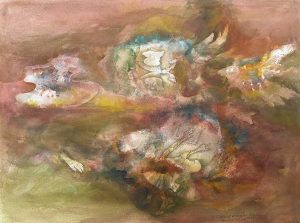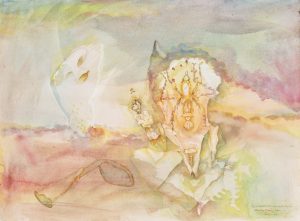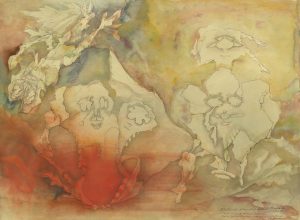
Aladár ALMÁSY
“On behalf of Horatius” – Szechenyi plough is husking the top of the Amphora for Homer
- Year(s)
- 2018
- Technique
- pastel, watercolour and ink on paper
- Size
- 57x76 cm
Artist's introduction
Aladár Almásy is one of the most distinctive figures of the generation of graphic artists of the 1970s, whose graphic universe is defined by mystical-psychological symbolism, romantic sensibility and linguistic humour. Noémi Szabó, art historian, described his distinctive character vividly: "He is invested in a romantic-surrealist eclecticism, constructing a dream world far from the current age, full of pretension, but at the same time honesty as well." Born in Debrecen, Almásy completed his graphic studies at the Hungarian College of Fine Arts in 1976. In the 1970s, together with Imre Szemethy, he was the successor of the generation of graphic artists that had defined the previous decade and had established an important tendency and which was marked by the names of Béla Kondor, Arnold Gross, Csaba Rékassy and Ádám Würtz. His first works were etchings, lithographs, aquatints, mezzotints, and pen and ink drawings. His aesthetic world was characterised by jagged, fragmented draughtsmanship, dreamlike, surreal visions and playful linguistic humour. His numerous national solo exhibitions were accompanied by several international exhibitions. In his scandalous statement of 1978, he described himself as an individualistic dreamer: "My existence is a unique visual world of forms, determined by inner emotions, a pure inexhaustible world view, never committed to any fix direction." He gradually drifted towards painting in the 1980s, combining cloud-like patches of colour with his broken line work. His art, which looked to the past, evoked the poetic mood of turn-of-the-century symbolism, from the metaphorical enigma of Baudelaire to the nostalgic dreamscapes of Lajos Gulácsy. The heroes of his poetic narratives are often drawn from cultural history (István Széchenyi, Martin Luther, Zarathustra, etc.). Around the turn of the millennium, the medium of bronze sculpture also appeared in his œuvre, which embraces a wide range of techniques. His successful start to his career was accompanied by numerous state awards in the 1970s and 1980s. He lives and works in Budapest. Gábor Rieder
More artworks in the artist's collection »








































